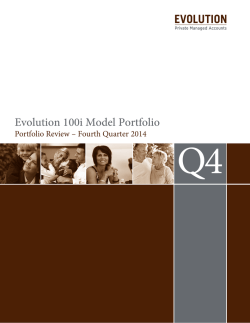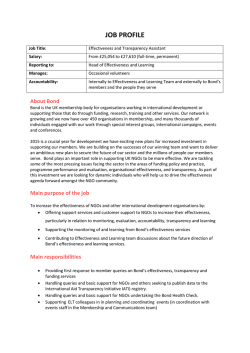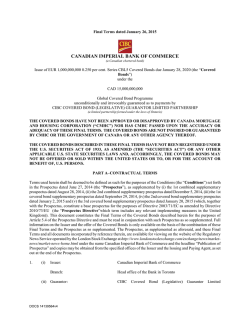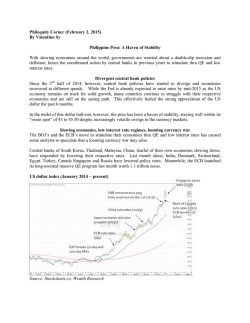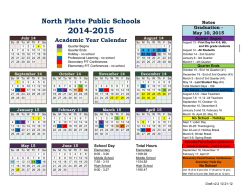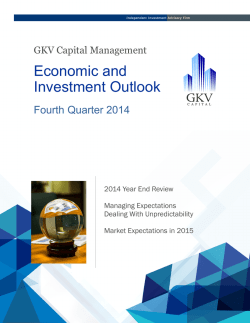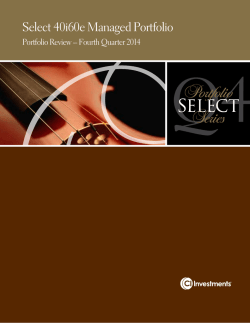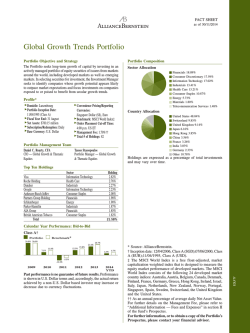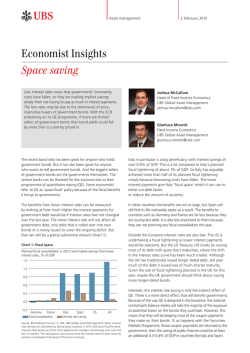
INVESTMENT BRIEFING - Vista Wealth Management
INVESTMENT BRIEFING Fourth Quarter, 2014 Explaining performance in the fourth quarter depended on which global market you looked at. Generally, it was a very nice quarter in the U.S. and poor elsewhere. Stocks of small companies reigned supreme while emerging markets suffered due to an appreciating dollar as capital flowed to the U.S. As illustrated by the table below, 2014 is an excellent example of why we diversify because the stocks of large and small companies traded places dramatically last quarter. Looking to the longer term, emerging market stocks still have the best performance. Asset Class www.vistawealth.com U.S. Stocks (Russell 3000) Small Cap U.S. Stocks (Russell 2000) Foreign Stocks (MSCI All Country World ex USA) Emerging Markets Stocks (MSCI EM) Real Estate Investment Trusts (MSCI World REITs) Taxable Bonds (Barclays 1-5 Year Gov) Municipal Bonds (Barclays Muni 3 Year) 4th Quarter 2014 5 Years (annualized) 10 Years (annualized) 12.56% 4.89% -3.87% 15.63% 1.78% 12.69% 8.43% 8.96% -2.19% 21.54% 0.45% -0.13% 1.18% 1.22% 1.75% 3.12% 2.97% 5.24% 9.73% -3.87% -4.50% 15.55% 4.43% 1.93% 7.94% 7.77% 5.13% 3.59% Advisory services offered through Vista Wealth Management LLC, a federally registered investment advisor. Securities also offered through ValMark Securities, Inc., member FINRA, SIPC. 130 Springside Drive, Suite 300, Akron, OH 44333. 800.765.5201. Vista and ValMark are separate companies. United States: Living Large The U.S. economy continued to pull away from most of the others in Q4, with employment growth reaching levels last seen in 1999. Most employment numbers continued to improve, although a large and important one, labor market participation, showed that more people dropped out of the workforce. The data showed that while the drop was due mostly to demographics (aging baby boomers), there were still discouraged workers who gave up on their job searches. The Federal Reserve continued to say that interest rates would likely increase in 2015 based on their reading of the unemployment numbers, although they too are concerned about participation. Setting employment aside for a moment and just looking at growth, U.S. GDP expanded at healthy rates both in the 2nd and 3rd quarters. Given these positive numbers, the stock markets shook off their earlier fears and came back strongly, as the numbers in the table show. At the same time, commodities, which have mostly been struggling for the last few years, continued their rout with the price of oil dropping almost in half. The reduced cost of oil should eventually give different sectors of the U.S. economy a nice boost as consumers redirect their energy expenditures to other goods. Looking forward, there are many positives that may continue to benefit our economy: Relatively low interest rates and a still mostly accommodative central bank An inflation rate that is under control Continued improvement of consumer balance sheets as their debt continues to drop Improving government deficits Negatives to keep in mind for the U.S. include: A rather expensive stock market An energy sector that may struggle as it adjusts to much lower oil prices A still-struggling Europe and Japan, who are important trading partners, and whose economies affect U.S. company profits The possibility of continued legislative gridlock in Washington Interestingly, the best performer across domestic and international segments was real estate, which was represented separately in your Vista portfolio as global REITs (Real Estate Investment Trusts). They returned more than 20% for the year overall. Everyone Else: Living Less There isn’t much mystery in the numbers: with the exception of the U.K. (who has mimicked many of the U.S.’s moves) much of the world’s economy is still struggling to recover from the financial crisis. Here’s a summary: The European monetary union did pull out of its double-dip recession, but just barely. There are three large positives on the horizon, however: Since Europe is a heavy importer of energy, cheaper oil could give them a nice boost. The European Community Bank (ECB) is ready to start its own version of quantitative easing, which could boost borrowing. A much cheaper euro, in dollar terms, should also boost their exports. Japan tried its version of quantitative easing also, named Abenomics, after their prime minister. Their actions initially helped, but an increase in Japan’s sales taxes put a serious crimp on the effort, resulting in an eventual reversal of the tax increase. Looking forward, as in Europe, their cheaper currency (yen to dollar) and oil may give them a nice boost. Emerging markets, which produce many of the commodities that have suffered lower prices, generally stumbled through the quarter (and the year). This included China, Page | 2 who continued dealing with reduced growth. While their currencies are also cheaper, the fact that many of their commodity exports are worth less means that they may continue to struggle. However, the long-term growth prospects remain good, especially in countries like India and China that continue building their middle classes. Living Large or Less: Currencies in Our Global Economy What is interesting to note, is how global stock markets did in terms of their own, local, currencies. Currency values tend to be strongly related to the interest rates being paid by their host countries. For example, if rates are higher in the U.S. than they are in the U.K., the dollar will typically be more valuable than the pound because investors are buying dollars to get our higher rates. Today, as the Federal Reserve talks about increasing rates while the European Community Bank talks about lowering theirs, the dollar has appreciated against the euro rather drastically. Currencies Reversed 2014's Returns 15.0 10.0 5.0 0.0 -5.0 -10.0 Local France Germany Dollar Japan UK Switzerland Australia What if we look at how foreign markets performed in terms of their own currencies? Here’s a graph showing, in the left set of columns, how a few major foreign stock markets did in terms of their home currencies (the euro for France, the yen for Japan, etc.). They were all positive. On the right are the returns that we experienced, as U.S. investors, holding their stocks in dollars. They were almost all negative. Note that this graph is only for one year: 2014. Interest rates change currency values sporadically. However, a stronger force over time are the values of goods and services, which tend to converge over longer time periods (what economists call “purchasing-power parity”). For example, if the price of a French bottle of wine drops enough in Europe, when compared to its U.S. price, more businesses will import wine from France, taking that profit for themselves. Eventually, French vintners will either increase their price in Europe or decrease their price in the U.S. to offset this, because they want to maximize their own profits rather than letting someone else take them. In this way, parity eventually results (according to the economic theory). Source: FTSE Indexes, Morningstar Direct Looking at the broader economy, with most of the goods and services being subject to this result, we see parity over time in the prices of stocks as well. The following chart looks at those same economies over longer time periods. What we’re showing here are the differences in returns between the dollar and each stock market’s home currency (and we threw in 2007 to show that there are years when the dollar lost value as dramatically as it gained value last year). As the chart shows, what were differences in returns of between about 2% and 14% for one year (either 2007 or 2014), were all less than about 2% over the entire 10-year period that began in 2005. Page | 3 Effects of Different Currencies Lessen Over Time 2007 2014 3 Years 5 Years 10 Years Return Differences - Dollar vs. Local Currency 15.0 10.0 5.0 0.0 -5.0 -10.0 -15.0 -20.0 France Germany Japan UK Switzerland Australia Source: FTSE Indexes, Morningstar Direct. Returns for 2014 and longer periods were through 12/31/14. For this reason, most stock investors, including Vista, do not hedge currency risk in order to minimize this. We are long-term investors and currencies should eventually align for the most part. That said, because bond returns generally aren’t as high nor as volatile as stock returns, currencies are hedged in our global bond funds. This action creates additional safety in our bond portfolios. Bonds: Still Alive and Headed for a Change Despite many professional predictions (a bit of an oxymoron, we know), interest rates on long-term bonds dropped during 2014. Although the Federal Reserve said that it would let rates increase in 2015, investors still bought bonds in droves rather than waiting. With inflation continuing to be low, the return that some bonds provide is attractive to investors regardless of the fact that rates will most likely rise sometime in the future. The Fed has been very clear that it will let rates rise in 2015 because the U.S. economy has continued to improve. Given this, we have decided to increase the maturity range of Vista’s bond portfolio during 2015. We should note that our portfolio maturity was longer before the Fed decided to strongly intervene in the bond market. Since the Fed has made it clear that it will let interest rates go back to more normal levels in 2015, we will also be moving to our normal, longer maturity, portfolio. Page | 4 We refer to our bond portfolio’s normal maturity as “intermediate” meaning bonds that generally mature within five to 12 years. While we currently have an average maturity of around three years, we will adjust the portfolio to an average maturity of approximately five years. This will reflect the longer planning horizon that is consistent with most of our clients’ financial plans. This will not change other aspects of our bond portfolios, for example, we will still be focused on high quality bonds (generally an average rating of AA). Our bond portfolio will also continue to be diversified across the globe, capturing interest rates from investment-worthy countries all over the world. Predicting interest rates is a fool’s game (just like predicting the stock market), so we will lengthen the average maturity of our bond portfolio during the next nine months, with 1/3 of the change being implemented each quarter. This will smooth the change, which is important when we’re making changes to our bond portfolio. We hope this briefing brings a little more light to the numbers you see in your reports. As always, we look forward to any questions you may have. Thank you for your trust in Vista. Your Vista Wealth Management Team Page | 5
© Copyright 2025
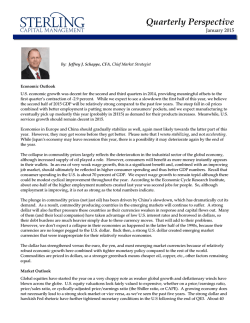
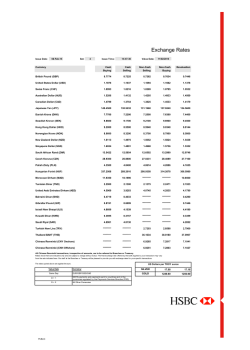
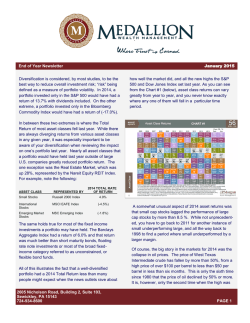

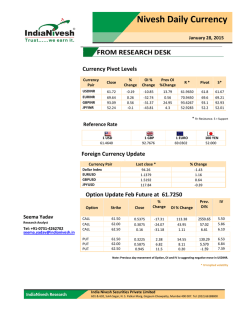

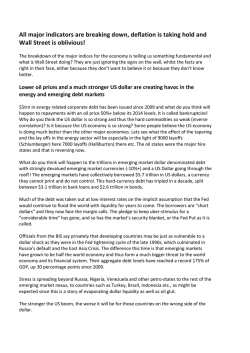
![Quarterly Commentary [PDF]](http://s2.esdocs.com/store/data/000473889_1-199d98d24dff63e8b8cda114308c276e-250x500.png)
